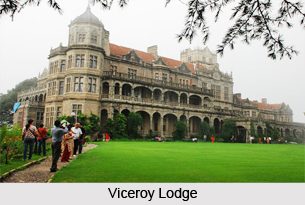 Monuments of Himachal Pradesh represent the glorious period of the Maharajahs and the colonial British rule in the beautiful province. The monuments include several forts and palaces of their previous rulers, colonial buildings of British Raj and lots of Buddhist monasteries. One of the major monuments of Himachal Pradesh is the Viceroy Lodge or the Rashtrapati Niwas in Shimla, constructed in a wonderful European architectural style. Apart from these the other popular monuments of Himachal Pradesh are Gurkha forts, Lord Elgin`s Memorial, Rang Mahal of Chamba, Maharaja Palace of Chail, Dhankar monastery, Guru Ghantal monastery and many others.
Monuments of Himachal Pradesh represent the glorious period of the Maharajahs and the colonial British rule in the beautiful province. The monuments include several forts and palaces of their previous rulers, colonial buildings of British Raj and lots of Buddhist monasteries. One of the major monuments of Himachal Pradesh is the Viceroy Lodge or the Rashtrapati Niwas in Shimla, constructed in a wonderful European architectural style. Apart from these the other popular monuments of Himachal Pradesh are Gurkha forts, Lord Elgin`s Memorial, Rang Mahal of Chamba, Maharaja Palace of Chail, Dhankar monastery, Guru Ghantal monastery and many others.
Architecture of Monuments in Himachal Pradesh
The architectural styles of the monuments of Himachal Pradesh vary from region to region. The religious monuments in the state symbolize the presence of different cultures through its variety of architecture and art which can be identified as Pent roof, Pagoda style, Tower style, Pyramidal style, Nagara style, Gomphas and Flat roofed temples. The Pent roofs of the religious monuments are the square or rectangular wood and stone temples. These are the most ancient forms of monuments found all over the hills of Himachal Pradesh. The Nagara style monuments are the Indo-Aryan temples, influenced by the Chinese or Tibetan architectural style. Similarly the Flat roofed, Tower style, Goompha style all vary from each other and represent a typical style of architectural development.
The colonial style of monuments of Himachal Pradesh represents the European architectural style developed during the British Raj. During the colonial rule, Himachal Pradesh was a favorite destination among the Britishers. They constructed several bungalows, cottages, castles, mansions, administrative buildings with the magnificent interior with priceless artifacts. These wooden architectures were designed beautifully with Belgian chandeliers, brass beds, and tiled fireplaces. Sometimes they used Burma teak for paneling the interior.
Significant Monuments in Himachal Pradesh
Himachal Pradesh is popularly known as the land of Gods and famous for its heritage monumental tours. Millions of tourist from all over the world visit here for its natural beauty and for famous monumental attractions that dots the wonderful landscape.
Rashtrapati Niwas
Rashtrapati Niwas, formerly known as Viceregal Lodge, is located on the Observatory Hills of Shimla. It was formerly the residence of the British Viceroy of India. It houses some of the most ancient articles and photographs dating back to the colonial period. The construction of the building was started in 1880 and was completed in 1888.
Hidimba Devi Temple
Hidimba Devi Temple, locally known as Dhungari Temple, is an ancient cave temple dedicated to Hidimbi Devi, wife of Bhima in the Indian epic Mahabharata. The temple is surrounded by a cedar forest called Dhungiri Van Vihar. The temple was built in 1553 by Maharaja Bahadur Singh.
Tabo Monastery
Tabo Monastery in Spiti Valley was founded in 996 CE in the Tibetan year of the Fire Ape by the Tibetan Buddhist lotsawa Rinchen Zangpo. It is noted for being the oldest continuously operating Buddhist enclave in both India and the Himalayas.
Kangra Fort
Kangra Fort was built by the royal Rajput family of Kangra State in 4th century AD, which traces its origins to the ancient Trigarta Kingdom, mentioned in the Mahabharata epic.
Champavati Temple
Champavati Temple was built by Raja Sahil Varman, believed to be the founder of modern Chamba in 920 AD, in the memory of his daughter, Champavati. Its architecture is quite striking featuring shikhara (spire) style, reminiscent of Nepali architecture.
Key Monastery
Key Monastery is a Tibetan Buddhist monastery of the Gelugpa sect located at an altitude of 4,166 meters (13,668 ft) above sea level, close to the Spiti River. It is the largest and oldest monastery of the Spiti Valley and a religious training centre for lamas. It reportedly had 100 monks in 1855.
Jaitak Fort
Jaitak Fort is situated about 1479 meters above sea level. The fort is notable due to its location and affords a view of the surrounding countryside due to its strategic setting.
Chokling Monastery
Chokling Monastery houses a grand and colossal stupa as well as an enthralling statue of Padmasambhava. This monastery is located in the Bir Tibetan colony. It was established in the 1960"s following the exile of Tibetans because of Chinese invasion.
Naggar Castle
Naggar Castle is a medieval castle, located in Kullu, Himachal Pradesh. Built by Raja Sidh Singh of Kullu in around 1460 A.D, it was taken over to Himachal Pradesh Tourism Development Corporation (HPTDC), to run as a heritage hotel, since 1978.
Kuthar Fort
Kuthar Fort was originally built by the Gurkha Kings 800 years ago when they ruled over this part of the land. Some portions of the fort are not more than a century old though. This fort is spread over a large area and fresh-water springs flow within its confines.
Nurpur Fort
Nurpur Fort was formerly known as the Dhameri Fort and was built in the 10th century. The fort was destroyed by the British and then by an earthquake in 1905. The temple inside the fort called Brij Raj Swami was built in the 16th century. It is known to the only place where both the idols of Lord Krishna and Meera Bai are worshiped.



















